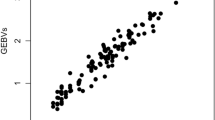Abstract
Methods for identifying germplasm carrying alleles with the potential to improve a particular single-cross hybrid have been proposed and discussed in recent years. There is a need for similar methods to be used in breeding crops for which pure-line cultivars, rather than hybrids, are the goal. The objective of this research was to develop a method to identify germplasm lines with the potential to contribute favorable alleles not present in a specified pure line or set of pure lines. Given a set of adapted pure lines (A 1, A 2 ..., A m) to be improved and a set of germplasm lines (P 1 P 2 ..., P f), the procedure consists of producing all f x m possible hybrids and evaluating them along with the parents. The testcross statistic T ij is defined by T ij=γ(F ij−A j)+(1−γ) (F ij−P i), where A j, P i, and F ij represent the performance of thej th adapted line, the i th germplasm line, and their hybrid, respectively. The statistic \(\bar T_i = \left( {{1 \mathord{\left/ {\vphantom {1 m}} \right. \kern-\nulldelimiterspace} m}} \right)\sum {\left( {T_{ij} } \right)} \) is the mean value of T ij over all adapted parents A j. If γ=(1/2)(1+d′), where d′ = the mean degree of dominance, then T ij measures the potential for alleles from P i to improve A j and \(\bar T_i \) measures the potential for alleles from P i to improve the set A 1, A 2 ..., A m. Use of data on soybean and peanut hybrids published by other researchers suggests that the value assumed for d′ has little effect on the P i chosen. The ability of the T ij and \(\bar T_i \) statistics to identify germplasm strains carrying rare favorable alleles should be assessed in empirical studies.
Similar content being viewed by others
References
Allan RE (1980) Wheat. In: Fehr WR, Hadley HH (eds) Hybridization of crop plants. American Society of Agronomy and Crop Science Society of America, Madison, Wisconsin, USA, pp 709–720
Burton JW, Carter TE Jr (1983) A method for production of experimental quantities of hybrid soybean seed. Crop Sci 23:388–390
Coffman WR, Herrera RM (1980) Rice. In: Fehr WR, Hadley HH (eds) Hybridization of Crop Plants. American Society of Agronomy and Crop Science Society of America, Madison, Wisconsin, USA, pp 511–522
Cregan PB, Busch RH (1977) Early generation bulk hybrid testing of adapted hard red spring wheat crosses. Crop Sci 17:887–891
Dudley JW (1984a) A method of identifying lines for use in improving parents of a single cross. Crop Sci 24:355–357
Dudley JW (1984b) A method of identifying population containing favorable alleles not present in elite germplasm. Crop Sci 24:1053–1054
Dudley JW (1987a) Modifications of methods for identifying populations to be used for improving parents of elite single crosses. Crop Sci 27:940–943
Dudley JW (1987b) Modifications of methods for identifying inbred lines useful for improving parents of elite single crosses. Crop Sci 27:944–947
Dudley JW (1988) Evaluation of maize populations as sources of favorable alleles. Crop Sci 28:486–491
Gerloff JE, Smith OS (1988a) Choice of method for identifying germplasm with superior alleles. I. Theoretical results. Theor Appl Genet 76:209–216
Gerloff JE, Smith OS (1988b) Choice of method for identifying germplasm with superior alleles. II. Computer simulation results. Theor Appl Genet 76:217–227
Hogan RM, Dudley JW (1991) Evaluation of a method to identify sources of favorable alleles to improve an elite single cross. Crop Sci 31:700–704
Isleib TG, Wynne JC (1983a) Heterosis in testcrosses of 27 exotic peanut cultivars. Crop Sci 23:832–841
Isleib TG, Wynne JC (1983b) F4 bulk testing in testcrosses of 27 exotic peanut cultivars. Crop Sci 23:841–846
Kenworthy WJ (1980) Strategies for introgressing exotic germplasm in breeding programs. In: Corbin FT (ed) World soybean research conference II: proceedings. Westview Press, Boulder, Colorado, USA, pp 217–223
Nelson RL, Bernard RL (1984) Production and performance of hybrid soybeans. Crop Sci 24:549–553
Paschal EH, Wilcox JR (1975) Heterosis and combining ability in exotic soybean germplasm. Crop Sci 15:344–349
Pfarr DG, Lamkey KR (1992a) Evaluation of theory for identifying populations for genetic improvement of maize hybrids. Crop Sci 32:663–669
Pfarr DG, Lamkey KR (1992b) Comparison of methods for identifying populations for genetic improvement of maize hybrids. Crop Sci 32:670–677
Rick CM (1980) Tomato. In: Fehr WR, Hadley HH (eds) Hybridization of crop plants. American Society of Agronomy and Crop Science Society of America, Madison, Wisconsin, USA, pp 669–680
Skorupska H, Palmer RG (1989) Genetics and cytology of the ms6 male-sterile soybean. J Hered 80:304–310
Smith EL, Lambert JW (1968) Early generation testing in spring barley. Crop Sci 8:490–493
Starling TM (1980) Barley. In: Fehr WR, Hadley HH (eds.) Hybridization of crop plants. American Society of Agronomy and Crop Science Society of America, Madison, Wisconsin, USA, pp 189–202
Sweeney PM, St. Martin SK (1989) Testcross evaluation of exotic soybean germplasm of different origins. Crop Sci 29:289–293
Zanoni U, Dudley JW (1989) Comparison of different methods of identifying inbreds useful for improving elite maize hybrids. Crop Sci 29:577–582
Author information
Authors and Affiliations
Additional information
Communicated by A. L. Kahler
Joint contribution: OARDC (Journal Articale No. 161-94), USDAARS, Iowa Agriculture and Home Economics Expriment Station (Journal Paper No. J-16109; Project 2985), and Agreculture and Agri-Food Canada. Salaries and research support for S. K. St. Martin Provided by state and federal funds appropriated to the Ohio Agricultural Research and Development Center, Ohio State University
Rights and permissions
About this article
Cite this article
Martin, S.K.S., Lewers, K.S., Palmer, R.G. et al. A testcross procedure for selecting exotic strains to improve pure-line cultivars in predominantly self-fertilizing species. Theoret. Appl. Genetics 92, 78–82 (1996). https://doi.org/10.1007/BF00222954
Received:
Accepted:
Issue Date:
DOI: https://doi.org/10.1007/BF00222954




